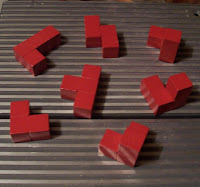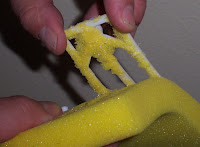Experiments with Colored Pencils
There I was in a hotel room in Orlando Florida. It was the first day of the Model Schools Conference put on by the
International Center for Leadership in Education. I had come prepared with some art supplies, since I knew it would be otherwise hard to keep rolling with this
30 Days of Creativity project while on the road.
I also crazily packed a little cardboard robot model my daughter recently gave me as a gift, but I admit to not working on it at all while I was there. I was able, however, to experiment with some colored pencils and old yellow paper.
 |
| Figure 1. A first colored pencil piece |
When it comes to art, my talents (if any) tend to be in the abstract realm. I had recently been playing around with ideas for how to incorporate recycled toilet paper rolls in an art project. One idea I played with a little was to cut the rolls open and attach them together to make a painting surface, create a painting, then disassemble the pieces and rearrange them in a new way. So, I decided to test some ideas that I thought might work for an eventual painting for this project.
Unfortunately, I neglected to sharpen my colored pencils before I came! I pressed on anyway and used whatever ones I could to get some sort of a line on the paper to create the swirly thing shown in Figure 1. That was my first night's work.
Sharpen Those Pencils!
The next night I made my way down to the lobby and looked around the business center for a pencil sharpener. No luck. What kind of a business center in a major hotel doesn't have a pencil sharpener? Plan B.
 |
| Figure 2. Drawing is better with sharp pencils |
I approached the registry desk and asked one of the employees if they happened to have a pencil sharpener I could use. One of the kind persons went to the back office area and returned with a basic electric model. She plugged it in for me and I proceeded to sharpen away. I was able to get about 90% of them sharpened before the sharpener seized and would sharpen no more. I returned the device with a "thank you," pretty certain it would come back to life once it cooled. Back to the room.
More Experiments With Colored Pencil
That evening and the next, I tried variations on the theme I had begun the night before (Figures 2-5). These came out better since the pencils were sharp(er).
Figure 2 was really nothing more than a test of how smoothly I could move the pencil tip over the surface of the paper. It is really quite amazing how the brain and hand can improve the performance of such a simple task in a short time. By the time I was done, my movement was much more steady and he sweep of eth curves much smoother compared to when I started
 |
| Figure 3. Use of overlapping lines |
Figure 3 is okay. It included a deliberate crossing of one swoop over another. just to guage the appeal of that effect.
These are just free form experiments with colored lines. It was a lot of fun and I am sure I learned something from the process, although exactly what is hard to say. Just because I can't quantify it, or pin it down, doesn't mean it doesn't have some value. At least to me.
I like Figure 4. This included a deliberate attempt (only partially successful) to not allow any of the swoops to cross over each other. I added some background to it just to see what effect it would have on the overall look. It seems to work.
Of these I do not much care for Figure 5. It looks too mechanical; like it was drawn with a machine of some sort. It's like something produced by a Spirograph.
 |
| Figure 4. Trying not to cross the lines |
Great art? Probably not. But, interesting enough to make me think something along these lines, done in more vibrant colors with acrylic paint, would work well for the toilet paper roll piece I had in mind (more on that later).
 |
| Figure 5. A spiral, more symmetrical design |
Previous Day
Next Day
























